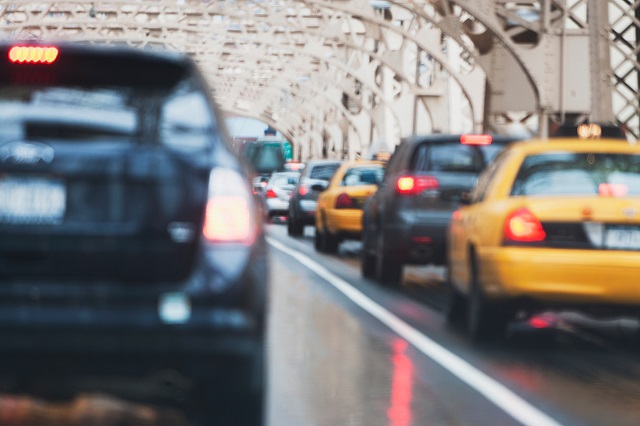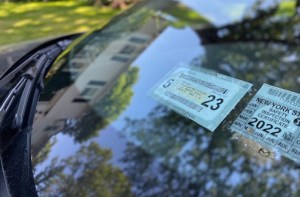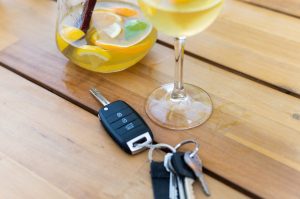Few things in life are more universally loathed than traffic – and rightfully so. Not only is road congestion a time-consuming inconvenience, it costs drivers money in the form of wasted fuel and increases harmful tailpipe emissions.
For such a common occurrence, traffic and its causes remain a mystery to many drivers. Sometimes the answer is obvious, such as in cases of a car crash or lane closure. In other instances, however, congestion seems to pop up out of nowhere. So, what causes traffic jams?
The State of Northeast Traffic
Before we dive into the cause of the problem, let’s define the problem itself. It will come as no surprise to locals to learn that the Northeast has some of, if not the worst, traffic in the country. New York (first) and Boston (fourth) are among the five most-congested American cities, according to the TomTom Traffic Index.
The study found that, on average, it took New York City motorists 24.5 minutes to travel about 6.2 miles (10 kilometers). That equates to driving roughly 15 mph. Other Northeast cities cracking the top 100 are Providence, R.I. (23); New Haven, Conn., (37); Rochester, N.Y. (41); Hartford, Conn., (63); Syracuse, N.Y., (73); and Albany, N.Y., (75).
A second study painted an even grimmer picture. The INRIX Global Traffic Scorecard ranks cities based on the total hours lost to traffic per driver. Boston (4) and New York (5) cracked the top five globally. Drivers in these cities were delayed 134 and 117 hours, respectively, in 2022. Domestically, Stamford and Providence were included among the 25 most-congested American cities.
What makes the INRIX report even more troublesome for Northeast motorists is its ranking of the U.S. corridors with the worst traffic. Six of the top 10 roadways are right in our backyard. Taking the top spot is Stamford’s southbound section of I-95, stretching between Sherwood Island Connector and Indian Field Road. Drivers traveling this 30-mile corridor lost an average of 34 1/2 minutes each day during rush hour. Other Northeast roadways making the list include I-93 in Boston, I-278 in New York along with Connecticut state highway 15 and the Merritt Parkway in Stamford.
What Causes Traffic Jams?
Traffic can be broken down into two categories: Recurring and nonrecurring. As its name implies, recurring traffic is the type you experience on a regular, if not daily, basis. It is the result of roads becoming fully saturated with cars, meaning there are more vehicles than the roadway can fit. Saturation is the leading cause of traffic in the United States, accounting for 50% of congestion, according to the Federal Highway Administration.
Nonrecurring congestion is any traffic jam caused by temporary disruptions that close part of a roadway. This category can be broken down further, including emergency situations (accounting for 25% of congestion), weather-related incidents (15%) and work zone closures (10%). Nonrecurring congestion can cause major backups as it is often unexpected, which prevents motorists from planning their commute accordingly, and usually leads to lane closures, leaving a smaller amount of available roadway for cars to pass.
Phantom Traffic Jams
You may have noticed another type of congestion missing from the aforementioned list. It’s a situation every driver has encountered: You’re driving along at a consistent speed when all of sudden traffic stalls. There must be a crash or lane closure up ahead, you think. But just a few minutes later, traffic begins to move at a normal pace.
What causes traffic congestion like this? It’s known as a phantom traffic jam, a type of congestion with no obvious cause. Obvious being the key word as there is, in fact, a cause. Phantom traffic jams occur when there is a minor disruption in traffic flow, such as an inattentive driver having to suddenly brake. When the proceeding drivers reach this disruption, they are forced to slow down, as a chain reaction. This sudden deceleration causes what researchers refer to as a traffic wave, one that crests at the site of the disruption and travels backward typically for 100 to 1,000 yards.
There needs to be enough cars on the road for these minor disruptions to create a noticeable slowing of traffic. In this sense, phantom traffic jams can be considered a subset of recurring congestion. But phantom traffic is more a result of something going astray than an overabundance of vehicles.
Tips for Dealing With Traffic
Knowing what causes traffic jams is one thing. Figuring out how to avoid it is another. While some congestion on the roadway is inevitable, following these tips will go a long way toward limiting your time stuck in traffic.
Know your destination. Missing an exit, driving in circles or cruising around looking for a parking spot adds to your driving time and keeps a slow-moving car on the road. Make sure to familiarize yourself with the route and destination before hitting the road.
Use GPS and navigation apps. These tools help guide you to your destination. They can also alert you of upcoming traffic jams and reroute you accordingly.
Be an efficient driver. If possible, drive at a time when you know fewer cars will be on the road. Limit your time driving by completing tasks and errands in one trip.
Give yourself space. Keeping a safe distance from the car in front of you helps prevent a crash, but it also goes a long way in limiting congestion. Sudden and rapid deceleration leads to phantom traffic jams discussed earlier. It’s best to maintain a consistent speed, which can only be done if you have enough space in front of you.
Give yourself time. This tip won’t necessarily prevent you from hitting traffic (unless you leave early enough to avoid it), but it will make your commute less stressful. Studies have shown that it is not necessarily the amount of time traffic consumes that causes stress, but the unpredictability of said time.
Carpool. Fewer cars on the street means less congestion. Carpooling also allows you to utilize high-occupancy vehicle lanes and bypass backed-up stretches of roadway.
Where have you experienced the worst traffic? Let us know in the comments below!
Head to Your AAA for more driving tips and insight.
18 Thoughts on “What Causes Traffic Jams?”
Leave A Comment
Comments are subject to moderation and may or may not be published at the editor’s discretion. Only comments that are relevant to the article and add value to the Your AAA community will be considered. Comments may be edited for clarity and length.















A great book to read is; TRAFFIC. But…I’d like to share with you the most insidious time waster while driving:
Left hand turns. We all know the rule when making a left hand turn at an intersection….move to the CENTER of the intersection with your blinker on and wait till safe to turn. What MOST people do it wait at the CROSS WALK keeping all cars behind them hostage. I’d bet if there was a study of how much time gets wasted collectiviely by all the stuck drivers behind the left hand turner it would rival all traffic jams.
Thank you! This is one of my pet peeves – drivers who don’t know the correct way to make a left turn.
Not to mention the drivers in the, “High Speed Lane” or Left Lane, that are often driving or texting at a mere 15 or 20mph SLOWER than the lanes to their right. Don’t they teach that in Drivers Education anymore? Oh I forgot, just go to the Brockton Registry of Motor Vehicles and for a small (extra) fee, they’ll hand you a license without an exam or road test. Anyone think THAT’s a problem?? I could go on for hours here. Todays cars have more technology in them than the cars I started learning in. People need to put their phone down and DRIVE. How many times to you see a luxury car or SUV, brand spanking new, with the driver holding their cell phone up to their mouth (like they’re taking a bite from a slice of pizza) talking away, going 20 mph slower that everyone else in the left lane, keeping the EXTRA safe distance of about 1/4 mile between them and the car in the next zip code in front of them?? I’m no expert, but I think if you spend 50 or 100 Thousand Dollars on a new vehicle, it might come with some Bluetooth or other wireless technology (CarPlay etc) or something to free up a hand from holding the phone. It may be illegal to text while driving or using a mobile device unless it it Hands Free, but lets face it . . . the police aren’t enforcing this because they don’t have nearly enough police on the road to do so.
What were the other Northeast roadways in the INRIX top ten?
CT route 15 and the Merritt are the same road – did INRIX double count?
CT 15 becomes the Wilbur Cross Parkway once you’re north of Sikorsky bridge (cross the Housatonic)
Some things left out here;
1. MTA / NYCTA has become well known for their mediocrity. My LIRR station is about 40 miles from Penn Station, and on a good day, trains take from an hour to 2 hours to do that 40 miles. On a bad day, the sky is the limit. And with the disaster known as the opening of service to Grand Central, it’s gotten far worse, with people having no idea if they’ll make their ‘connection’ at Jamaica, with those with disabilities often finding broken elevators. COVID may have driven a lot of people to their cars, but the LIRR chaos since then sure hasn’t helped.
2. We sometimes have to drive from Queens to Brooklyn, and pretty much every time, it can take 2 hours to go several miles. Bad light timing doesn’t help. Nor do the potholes.
3. Super aggressive drivers, also DUI drivers on area roads, kids illegally driving kids late at night, the horribly designed LI roads, the awful off ramps and on ramps for the Northern State Parkway (emphasis on Park), unlicensed drivers, and hardly any traffic enforcement don’t help. Then again, there’s the purely awful condition of these state supposedly maintained roads.
In the “Leave Space” portion of the article, I had to chuckle as inevitability when driving the expressway into/out of Boston the moment you back off to leave a marginally safe distance between you and the vehicle ahead some fool automatically fills in the space.
Not just in the Boston area! Happens here in southwestern CT all the time, sad to say.
Yep. Thought the same. NJ as well. I like to leave space, but that only lasts 30 seconds.
Yup Here in RI too. Drives me NUTS !
I agree if you have to drive in congested areas, leaving early to beat the traffic works. If the MBTA can ever get out of their own way, then commuting by rail with have increased ridership. They’re making strides, but at the same time I wish they’d stop stumbling their way to the top. I truly want and believe it will happen.
Personally, I believe the biggest cause of traffic jams are bad drivers, and most drivers on the road are bad. If everyone drove well, such as proper lane changes, not driving in the left lane…slow drivers in the left lane choke off the ability to have faster moving traffic which means cars will get to their destination faster and get off the road faster, paying attention so as to keep traffic moving smoother and of course avoiding accidents. Imagine how much better traffic would be if there were never any accidents. The second cause is bad traffic controls of which Boston and NY are notorious for.
You hit all the right points! Bad drives, slow left lane drivers., and not paying attention. Drivers don’t communicate enough . I like signal lights before you just jump over. And let people merge in so we can flow
The problem with signaling before moving over is that the drivers on the other lane do not want you to get in front of them so they speed up. Happened to me yesterday when I came across cones in a construction zone. They preferred the risk of hitting me than to let me in.
Also, let’s not forget rubbernecking. My biggest pet peeve.
I agree with you 100%, Michael!! I have been saying that for years! One thing that really makes me crazy is when drivers stay in the passing lane! That really bogs down traffic! If you want to go slow, move over! Don’t these people know the rules of the road? The police should be ticketing them for being in the wrong lane! When I go around them and then look in my rearview mirror, they still don’t get it! They continue to stay in that lane!! It’s maddening!!
1. Slow drivers in the left lane, not watching their rear view mirror. The right lane is for entering and exiting, and slower drivers, the middle is the “travel lane” and the left lane is for passing. When in two lanes, left is for passing. So many times I can drive on the Merritt Parkway or i95 in Connecticut and an entire line of traffic is in the left lane and the right lane has 30% the cars. Many times the right lane is faster!
2. People not paying attention to the road. Texting, tuning the radio, talking, eating. Please pay attention.
3. Merging! Please merge at the merge not before! Drivers will decide to merge before they need to so one car merges, then a few cars later someone else decides to merge. If we all merge at the merge it is like a zipper and goes much faster than holding up more cars in the lane to which one is merging.
4. Cars that zip in and out of traffic, weaving and then seem to get nowhere. I see this a lot with modified little hondas or nissans. Mostly immature drivers.
5. We need tougher driving tests. Here in the states one takes the test enough times one will pass. In other countries with stricter testing there are less cars on the road and less accidents. Driving is a privilege not a right. Not all people are or can be good drivers.
6. One should know their driving abilities and be honest. I have elderly friends who will only drive when rush hour is over, will not drive at night, and they eventually stop driving for the sake of other people. One friend stated he will not drive at night, not due to glare, but shadows. He said he would not be able to live with himself if he accidentally hit a pedestrian that he did not see on the side of the road or coming from the shadows.
For a while I was driving from N. Providence, RI into Boston College. During the comute in for 9 am it would take about 2 hours to make this trip. On a Saturday Morning it was just under 1 hour to make this trip at the same time in the morning.
when I’m stuck in traffic I realize I am part of the problem!
Its good to point out that heavy traffic is unstable, and a small slowdown can snowball to a more significant delay.
Another solution is to try transit, especially in NY and Boston that have robust choices. But even in mid-size Providence the transit system is often better than non-users think it is, and riding transit you can relax on the ride, read a paper, chat…check it out!